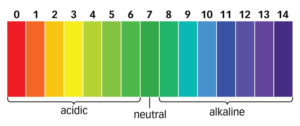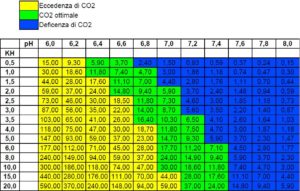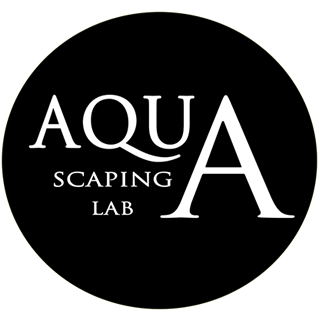06 Jul GH KH PH VALUES IN AQUARIUM: Water Hardness and acidity
Starting and managing an aquarium means creating a water biosystem composed by many elements, such as plants, animals and materials of biological origin or not. To ensure that this biosystem works and therefore the “Nitrogen Cycle” is active, water values must be monitored and administered according to the needs of the species of plants or fish that you have in the tank. In this article we will explain what are the PH, KH and GH values and the ideal ranges that must be observed, we recommend looking at our fish and plant data sheets to know the different needs of the species:
 PH VALUE: Ph indicates the acidic, neutral or basic nature of water. The so-called soft waters are the most acidic ones, while the hard waters are the most alkaline ones, or rich in Calcium ions, Magnesium ions and some heavy metals. To determine the degree of acidity of an element, there is a scale ranging from 0 (acid) to 14 (basic) where number 7 indicates neutrality. Various methods that you can use in aquariology to modify the pH of water and adapt it to the species present in the tank are: use of allophonic substrate (PH decrease), introduction and dissolution of Carbon dioxide Co2 (PH decrease), immission of osmosis water (ph 7 neutral), or the introduction of carbonates or salts (PH increase).
PH VALUE: Ph indicates the acidic, neutral or basic nature of water. The so-called soft waters are the most acidic ones, while the hard waters are the most alkaline ones, or rich in Calcium ions, Magnesium ions and some heavy metals. To determine the degree of acidity of an element, there is a scale ranging from 0 (acid) to 14 (basic) where number 7 indicates neutrality. Various methods that you can use in aquariology to modify the pH of water and adapt it to the species present in the tank are: use of allophonic substrate (PH decrease), introduction and dissolution of Carbon dioxide Co2 (PH decrease), immission of osmosis water (ph 7 neutral), or the introduction of carbonates or salts (PH increase).
PH ideal range value:
± 7
 KH VALUE: Kh represents the temporary carbonate hardness that expresses the amount of carbonates and bicarbonates, usually characterized by calcium and magnesium in water. The Kh value also represents total alkalinity and has a buffer property that stabilizes the PH by preventing acid or base swings, it also serves to calculate the CO2 concentration in relation to PH. To reduce the KH you will need to elimiante the cause such as the presence of limestone or tap water too hard and eventually eliminate or dilute the water in the tank with osmosis water that has KH = 0. If you want to increase the KH it is advisable to use special products to be put into water such as sodium bicarbonate and potassium bicarbonate or insert bones of cuttlefish or egg shells inside the filter. Be careful, this value must never be below the predetermined ranges otherwise it may cause bad fish development or death. If the level of kh is too high can cause problems with the absorption of nutrients of the plants and therefore not good growth.
KH VALUE: Kh represents the temporary carbonate hardness that expresses the amount of carbonates and bicarbonates, usually characterized by calcium and magnesium in water. The Kh value also represents total alkalinity and has a buffer property that stabilizes the PH by preventing acid or base swings, it also serves to calculate the CO2 concentration in relation to PH. To reduce the KH you will need to elimiante the cause such as the presence of limestone or tap water too hard and eventually eliminate or dilute the water in the tank with osmosis water that has KH = 0. If you want to increase the KH it is advisable to use special products to be put into water such as sodium bicarbonate and potassium bicarbonate or insert bones of cuttlefish or egg shells inside the filter. Be careful, this value must never be below the predetermined ranges otherwise it may cause bad fish development or death. If the level of kh is too high can cause problems with the absorption of nutrients of the plants and therefore not good growth.
KH ideal range value:
Medium range 4 – 6 °KH
Poecilidae 8 – 10 °KH
African Cichlid ± 20 °KH
Salt water fishes 10 – 15 °KH
GH VALUE: The GH value represents the total hardness that is composed by the temporary hardness indicated by KH and the permanent hardness comprising Sulfates Nitrates, Chlorides and all other salts dissolved in water. To reduce the degree of GH you will need to eliminate the cause such as the presence of limestone or tap water too hard and eventually eliminate or dilute the water in the tank with osmosis water (GH = 0).
GH ideal range value:
4 – 8 °dh
In conclusion, to manage in a good way your aquarium and therefore plants and fishes healt, you must to verificate frequently PH, GH and KH values with the help of appropriate reagent strips to be immersed in the aquarium (unreliable) or with liquid reagents to be evaluated in the test tube (Very reliable). You will need to adapt the values to the needs of the animals for not cause bad development of plants and animals or algae formation. We recommend doing olso water tap analysis before entering it into the aquarium because can damaging all biosystem.



 English
English Italiano
Italiano